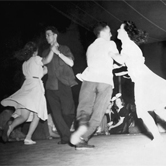On November 12, Square Dance: A Community Project will take over the Trinity River Audubon Center. Funded in part by an Idea Fund Grant from the Andy Warhol Foundation for the Visual Arts, the curators behind the Saturday night hoedown, Cynthia Mulcahy and Leila Grothe, say the dance is about more than just some community fun. It’s a performance piece that pushes the definition of contemporary art. We spoke with Mulcahy about the ideas fueling this latest manifestation of “art as social action.”
FrontRow: I thought we’d start where most people will start if they hear about the project. You’re throwing a Square Dance, so why call it art? Why can’t it just be a square dance?
Cynthia Mulcahy: I like your style, Peter. Is a square dance art? The proposal of art as social practice in the form of an outdoor seasonal dance I find very interesting. Fundamentally, I think it’s a belief in cultural practices and the value of historical traditions as well as an emphasis non-commercial definitions of art. My co-curator Leila Grothe and I are very interested in ideas of community and place, which was the starting point for this project.
FR: So the challenge, then, since this is very much a project that exists through participation, is how do you get members to the event and invested in the event? What have been your strategies on that front?
CM: Yes, participation IS the project, both in process leading up to the event and in the event itself. Our strategy in reaching out to new audiences has been legwork. We have approached as many different angles as we can think of, from attending community meetings to contacting middle and high school dance teachers.
The hardest part is getting folks to attend, once they are there it’s up to our square dance caller to get them on the dance floor! But dancing or not, the focus is on creating an event that brings people together.
FR: So why Square Dancing?
CM: Square dancing is our official national as well as State ofTexas folk dance and, by its very nature, requires participation on the part of the audience. You cannot just dance with the one you came with, rather you participate as a group and interact with new people. It’s practically a team sport in learning and combining the moves taught by the caller. Everyone starts at the same time (six-ish at this event) and builds on the instruction provided. Since no prior knowledge is actually required, it has a neutralizing effect.
Dallas has a history of free outdoor seasonal dances–mostly square dances–provided by the city going back to the 1940’s and earlier. Much documentation exists at the City of Dallas Municipal Archives about the dances, the musicians, and letters from Dallas citizens, chiefly from the early fifties.
The participatory aspect is what this public art project is all about from audience participation to the collaboration of the musicians and a licensed square dance caller to our local community – be they graphic designers and screen printers, caterers and eco-ware providers, municipal archivists or hay farmers – all have eagerly collaborated in making this project happen.
In like manner, funding for the event has been participatory. Small donations provided via crowd-source funding on kickstarter.org, four local art philanthropists, as well as an Idea Fund grant from The Andy Warhol Foundation for the Visual Arts has allowed many to take ownership in the project. Keeping the event free is important to us, and this support makes that possible.
FR: Will the project be documented in anyway, or is the fun of it that it is a momentary, one time thing, like theater?
CM: Yes, the event will be documented. The Idea Fund asks that we document our project, but the images and video are not what’s important to us. The event is the art, the experience is what matters.
Image: via.





